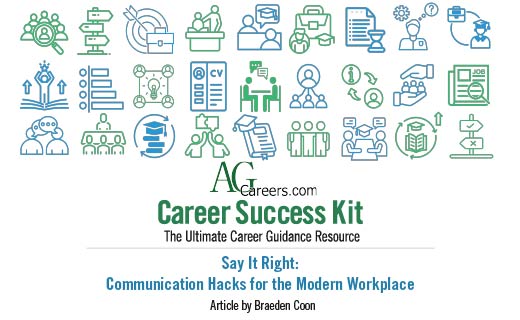- Candidates
- Login
- Set Up Account
- Create a Job Alert
- Search Tools
- Resources
- Employers

Because you can’t just hit them with “lol” and hope for the best.
Welcome to college life’s unofficial second major: professional communication.
Whether you're interning at an ag company, emailing a professor about a conference you want to attend, or messaging your supervisor on Teams about a project deadline, digital communication is part of your leadership toolkit. And let’s be real, it can feel a little weird to go from texting your roommate about ramen to emailing a recruiter about a networking event.
We’ve got you. Here’s how to keep it confident, clear and career-ready.
EMAIL: First Impressions Matter
Think of email like your digital handshake. You don’t need to sound robotic but you do need to sound like you’re ready to lead.
Do:
Write a real subject line.
Bad: “Hey”
Better: “Follow-Up on Resume Submission – John Smith”
A good subject line helps people know what to expect and keeps your message from getting lost.
Use a greeting.
Start with “Hi Dr. Jones,” or “Hello Ms. Taylor,” instead of jumping in cold. It’s a small gesture that shows respect.
Get to the point.
Be clear. Be kind. Don’t make people dig through three paragraphs to figure out what you’re asking for.
Sign off like a pro.
“Best,” “Thanks” or “Sincerely” all work. Always include your full name and contact info, especially if it’s your first time reaching out.
Proofread. Seriously.
You’d be surprised how fast “manger” instead of “manager” gets noticed. Read it out loud. Use spell check. Give it one more glance before you hit send.
Don’t:
Leave the subject line blank.
This isn’t a text. Subject lines matter.
Use slang or shorthand.
Avoid “u,” “lol,” “idk,” or “slayyyy.” You’re not texting your group chat. (Yes, even if you are slaying that project.)
Write a novel.
Respect their time. Use short paragraphs, headers or bullet points if you have a lot to say.
Ghost them.
If someone takes the time to respond, reply. Even a simple “Thanks so much—I appreciate the update” keeps the communication loop closed and professional.
Scenario:
Let’s say you’re applying for an internship and following up with the recruiter. A well-structured email with a clear subject line and a brief, polite message shows you’re on top of your game, and someone worth keeping on the radar.
TEAMS CHATS: The Digital Hallway
This is where most of your quick convos will happen: questions, updates, check-ins. It’s fast-paced but still professional.
Do:
Match the tone.
Lurk before you leap. Some teams love emojis and GIFs, others keep it all-business. Don’t assume.
Respond, even briefly.
“Got it,” “Thanks,” or ?? goes a long way. It shows you’re present and paying attention.
Use threads.
Keep convos organized. If someone’s chatting about a report, don’t jump in with a reminder about lunch sign-ups. Start a new thread or private message.
Check your status.
If you’re away, in class or heads-down on a project, update your status. “Back at 2 p.m.” is helpful. So is setting notifications appropriately.
Don’t:
Drop a three-paragraph ask in the group chat.
Long message? Move it to a thread or send it via email.
Message at midnight and expect a reply.
Just because you’re a night owl doesn’t mean everyone else is. Save it as a draft or schedule it to send during work hours.
Forget context.
Don’t just say “Did you get this?” Drop a line like, “Hey! Just checking in on the speaker request I sent last Friday, any updates?”
Scenario:
You need feedback on a social post design. Rather than spamming the main chat, you drop a short note in the thread: “Hey team could you take a look at the IG draft in the folder when you get a sec?” Professional, respectful and effective.
Pro Tips to Lead the Inbox (and Chat):
Keep it human.
Professional doesn’t mean stiff. Be friendly, but clear.
Assume good intent.
Tone can get lost in text. If something feels off, clarify before reacting.
Clarity over cleverness.
Sounding smart isn’t as important as sounding understandable. Ditch the jargon if it muddies your message.
Your communication style is part of your leadership presence. Own it. Practice it. And remember, just because it’s digital doesn’t mean it’s casual.
This is your time to show up, speak up and stand out — one message at a time.